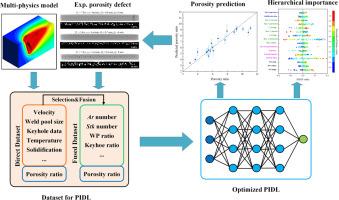Toward prediction and insight of porosity formation in laser welding: A physics-informed deep learning framework
IF 8.3
1区 材料科学
Q1 MATERIALS SCIENCE, MULTIDISCIPLINARY
引用次数: 0
Abstract
The laser welding process is an important manufacturing technology for metallic materials. However, its application is often hindered by the occurrence of porosity defects. By far, an accurate prediction of the porosity defects and an insight into its formation mechanism are still challenging due to the highly nonlinear physics involved. In this paper, we propose a physics-informed deep learning (PIDL) framework by utilizing mechanistic modeling and experimental data to predict the porosity level during laser beam welding of aluminum alloys. With a proper selection of the physical variables (features) concerning the solidification, liquid metal flow, keyhole stability, and weld pool geometry, the PIDL model shows great superiority in predicting the porosity ratio, with a reduction of mean square error by 41 %, in comparison with the conventional DL model trained with welding parameters. Furthermore, the selected variables are fused into dimensionless features with explicit physical meanings to improve the interpretability and extendibility of the PIDL model. Based on a well-trained PIDL model, the hierarchical importance of the physical variables/procedures on the porosity formation is for the first time revealed with the help of the Shapley Additive Explanations analysis. The keyhole ratio is identified as the most influential factor in the porosity formation, followed by the downward flow-driven drag force, which offers a valuable guideline for process optimization and porosity minimization.


对激光焊接中孔隙形成的预测和洞察:一个物理信息深度学习框架
激光焊接是一种重要的金属材料制造技术。然而,多孔性缺陷的出现往往阻碍了其应用。到目前为止,由于涉及到高度非线性的物理特性,对孔隙度缺陷的准确预测和对其形成机制的深入了解仍然具有挑战性。在本文中,我们提出了一个基于物理的深度学习(PIDL)框架,利用力学建模和实验数据来预测铝合金激光焊接过程中的孔隙率水平。通过适当选择凝固、液态金属流动、锁孔稳定性和焊池几何等物理变量(特征),PIDL模型在预测孔隙率方面显示出极大的优势,与使用焊接参数训练的传统DL模型相比,其均方误差降低了41%。此外,将选择的变量融合为具有明确物理含义的无量纲特征,以提高PIDL模型的可解释性和可扩展性。基于训练良好的PIDL模型,在Shapley加性解释分析的帮助下,首次揭示了物理变量/过程对孔隙度形成的分层重要性。钥匙孔比是影响孔隙度形成的最大因素,其次是向下流动驱动的阻力,为工艺优化和孔隙度最小化提供了有价值的指导。
本文章由计算机程序翻译,如有差异,请以英文原文为准。
求助全文
约1分钟内获得全文
求助全文
来源期刊

Acta Materialia
工程技术-材料科学:综合
CiteScore
16.10
自引率
8.50%
发文量
801
审稿时长
53 days
期刊介绍:
Acta Materialia serves as a platform for publishing full-length, original papers and commissioned overviews that contribute to a profound understanding of the correlation between the processing, structure, and properties of inorganic materials. The journal seeks papers with high impact potential or those that significantly propel the field forward. The scope includes the atomic and molecular arrangements, chemical and electronic structures, and microstructure of materials, focusing on their mechanical or functional behavior across all length scales, including nanostructures.
 求助内容:
求助内容: 应助结果提醒方式:
应助结果提醒方式:


